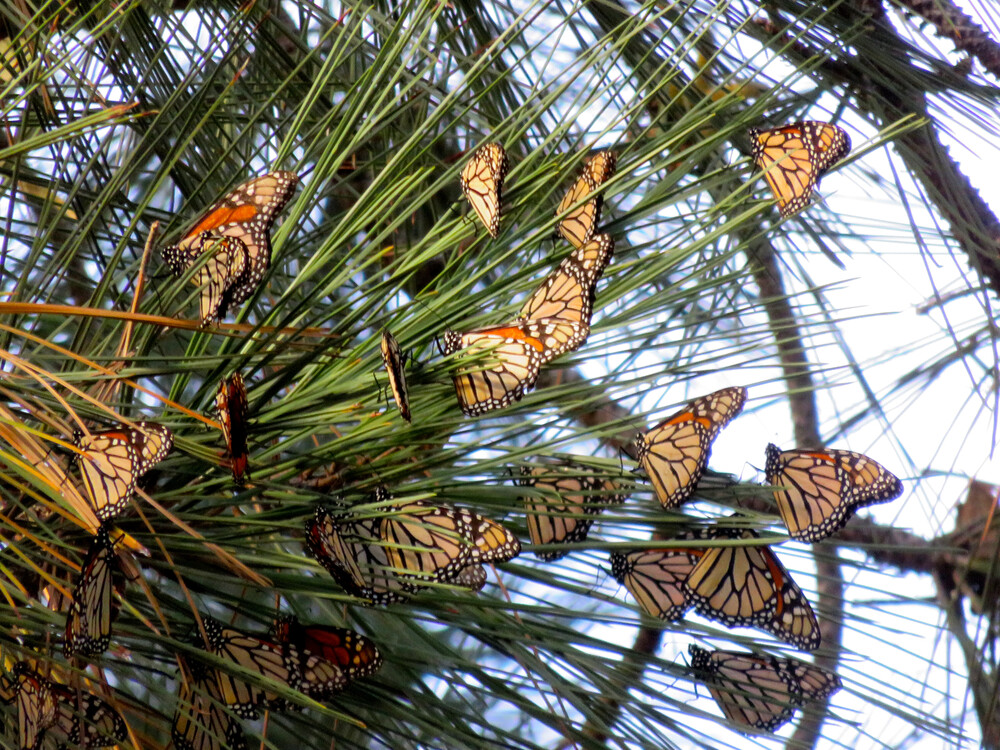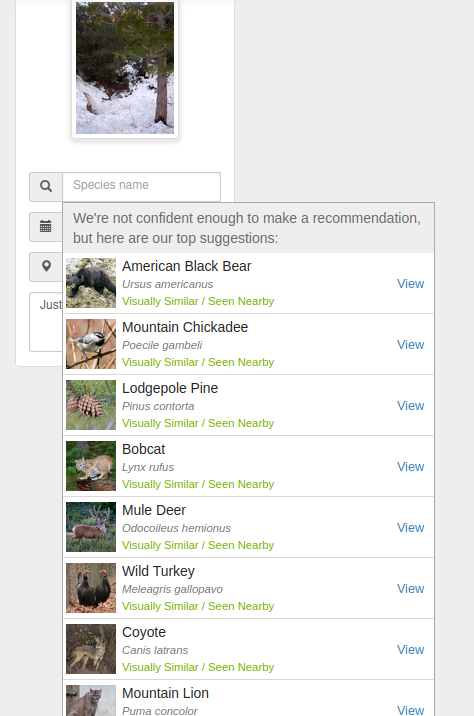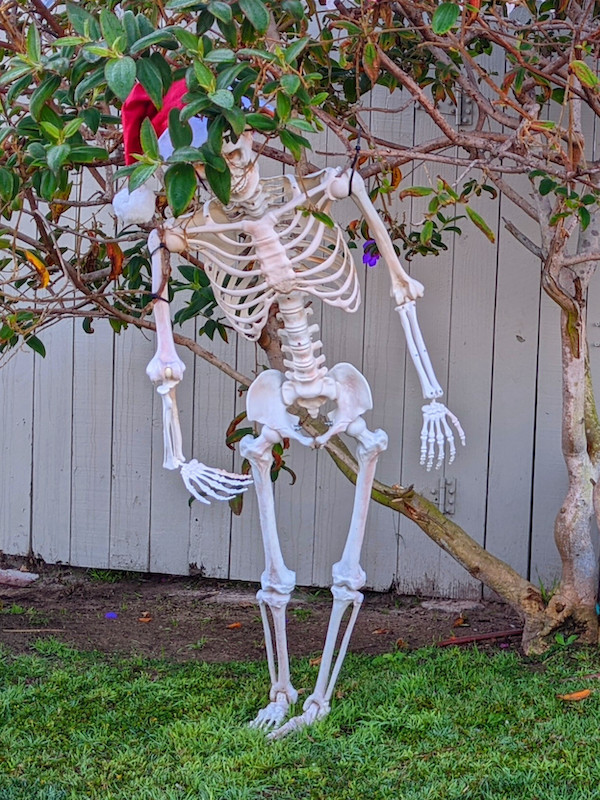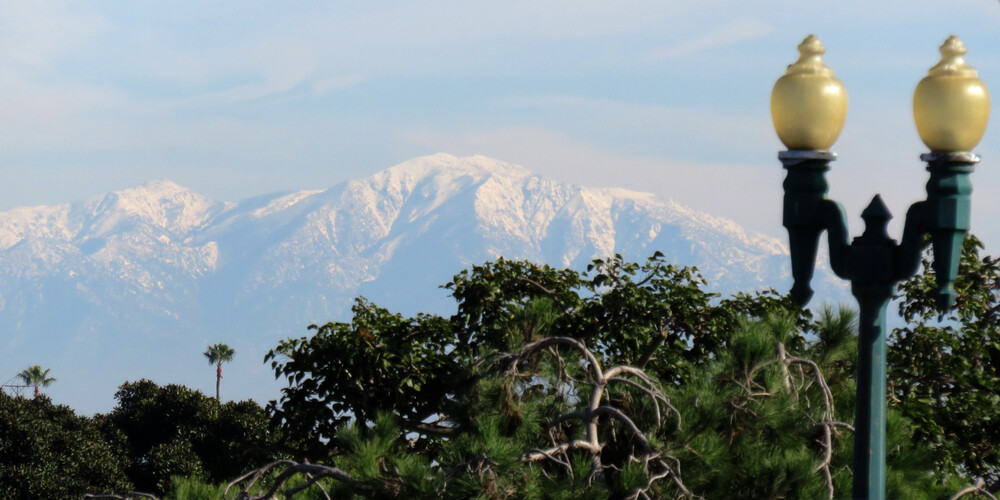Saw this while out walking this morning. I guess holiday decorations can last as long as you want them to!
Author Archives: Kelson
Monarchs!
From this afternoon’s walk along the greenbelt: About as many monarch butterflies in one photo than I’ve seen in the last few years!

There were a whole bunch of them clustered on a pine branch above the path. I wouldn’t have even seen them, but other people out walking had stopped to check them out.
I was just reading that this year’s overwintering monarch count is up to over 200,000 – a huge improvement over last year’s count of, I kid you not, 1,914. Though still not up to the millions that were regularly seen as recently as the 1990s. That article lists ways you can help the iconic species rebound, or you can follow the Xerces Society’s Monarch Call to Action.
Far Snows
We actually got quite a bit of rain (for Southern California, anyway) in December, and the mountains have stayed cold enough that the snow has stuck around for a few weeks!
Here’s a view of the San Gabriels in mid-December, after a big storm.
And here’s a comparable view a week into January.
Nowhere near as impressive as, say, the entire range being covered in 2008, but that’s a rare occurrence even in non-drought years…and we’ve had mostly warmer and drier years since then.
I know tastes are supposed to change over time, but this is ridiculous
The weirdest thing about the apparently-not-actually-Covid case I’ve got has been its effect on taste and smell.
It’s already starting to go back to normal, but for a couple of days it went really wonky. It never went out completely. It was more like taking an audio equalizer and readjusting the sliders so that some frequencies are barely audible and others are louder than they should be. And maybe shifting tracks out of sync while you’re at it.
Umami was the only taste that stayed intact, so flavors like cheese were fine. Sour was blunted in some cases, overpowering in others. And sweetness was both faint and delayed, which was really strange.
Seriously: I tried a chocolate chip cookie, and at first it was like eating a cracker or plain biscotti, but after a few seconds of chewing I could taste the chocolate and then the sugar.
I could taste the garlic on roasted potatoes, but could barely taste the potatoes. I could taste soy sauce in a stir-fry sauce, but not the ginger. I could taste the bitterness of kale, but couldn’t taste anything of the carrots.
Spice, Spice, Maybe?
I did some experiments with smell and the spice cabinet. I could smell most of the dried herbs fine – oregano, thyme, dill, cloves. Rosemary was kind of faint, but I could pick it up.
Garlic was seriously intense.
I could smell cinnamon but not nutmeg, which I thought was odd.
But the really weird one: paprika, ancho, black pepper, cayenne and ginger all smelled subtly off from normal. It was like when you get a chile of a type that’s normally spicy, but isn’t, and you can still taste the flavor but it doesn’t have the bite you expect.
Saucy!
I also tried tasting a few sauces.
Ketchup and mustard tasted more sour than usual. Plain yellow mustard was so intensely sour I couldn’t stand it!
Teriyaki tasted a little more like sweet and sour sauce.
Gochujang and caramel were both a little bit off, but I can’t quite place how.
Chocolate syrup was interesting, because I could pick up the chocolate taste before the sweetness, so it started out tasting like darker chocolate.
The same thing happened with chocolate candies. We have an assortment of Ghirardelli squares, and I tried a few of them: the 60% cocoa tasted like the 72% normally does. The filling on the mint was more noticeable than its chocolate coating. And the sea salt caramel just tasted like salty chocolate.
An unwanted guest for the new year
It’s theoretically possible that I picked up a cold in the middle of a surge in a highly-transmissible virus that, in people who have been vaccinated and boosted, has exactly the symptoms I have, and started about a week after a possible exposure.
It could happen. [Edit: apparently it did. See the update below.]
But we all know what William of Occam would say about that.
(No, this is not a good time to reread Eifelheim.)
Anyway, we had a possible exposure to Covid-19 last week. With the winter+omicron surge, we couldn’t get any at-home tests at all, let alone enough for three people. So we booked the first drive-through testing appointment we could get, which was still a week out.
We’d already planned a low-key Christmas at home with a family Zoom call, and we haven’t resumed going out places anyway. We’re still doing most of our shopping by store pickup or curbside pickup.
None of us came down with anything over the next week…
But this morning I woke up late, still fatigued, hoarse, with a runny nose and brain fog.
Well, that probably answers that question.
It was a self-administered drive-through test at a pharmacy, the kind where they pass the kit to you through a sliding drawer under a closed window, you swab your nostrils and put the swab in a collection vial, and pass it back through the drawer. Minimal air transfer. There were only two cars ahead of us, but it took almost half an hour to get up to the window (probably because one or both of them were also doing covid tests), and about 15 minutes to check us all in, send the test kits over, do the test, and send it back.
It was late afternoon when we got back. Between lunch and getting back from the test, my senses of taste and smell went wonky. I could barely smell the orange I picked up. I tried a chocolate chip cookie, and each bite started off tasting like a plain cracker, then picked up the chocolate taste as I chewed it.
So, yeah, looks like I’m ringing in the new year with Corona. Here’s hoping I’m the only one of us who gets symptomatic.
In a sense, though, this is the best time it could have hit us over the last two years. The world knows a lot more about how Covid spreads and how to treat it. There are treatments that didn’t exist two years ago. And vaccines! The three of us are all recently vaccinated or boosted, which makes a huge difference in chances of getting a severe case to begin with. Because of that, we’re more likely to have caught the variant that’s good at evading immunity, but comparatively mild when it does. And since we were all exposed at the same time, there’s no point in trying to isolate from each other. One of the lessons we learned when I came down with the flu at the start of all this was that it would be really difficult to properly isolate just one of us in this place.
So, um, happy new year?
Update Jan. 1
All three of our tests came back negative. So I don’t know what I have, but apparently it’s not COVID?
Time to re-apply Occam’s razor with new information.
- We were all exposed to someone who came down sick the next day.
- I have symptoms consistent with an Omicron breakthrough infection in someone who has been both vaccinated and boosted.
- Katie and the kid have both had a few odd things happen that, in retrospect, might be illness-related or might not be.
- All of us tested negative.
So:
- All three tests being false negative seems very unlikely.
- Mine could be a false negative, and both of them fought off the virus without noticeable symptoms, and legitimately test negative now.
- Or all three tests are accurate and I really did manage to catch something else in the middle of a surging wave of a covid variant matches my symptoms.
Weirdly enough, I’m kind of disappointed. I’ve been waiting for the other shoe to drop for almost two years and thought it finally had, and dropped in a way that would do minimal damage to the three of us.
Since I’m definitely sick with something, I’m still going to isolate. Just to be sure.
Update Jan. 6
It turns out the person I caught it from also tested negative for Covid during their illness…and then came down with actual Covid after they recovered. Fortunately they seem to be on the mend from that now too.
That means (a) whatever I caught from them wasn’t Covid and (b) we haven’t been around them in long enough that we don’t have to worry about it having been a Covid exposure too.
Have You Confused Your iNat Lately?
I confused the iNaturalist identification AI with some random snapshots from a trip up into the mountains a few years back.
Normally it’s pretty good at narrowing things down to a family or genus. In this case, I was aiming for scenery and family snapshots at the time, so they weren’t exactly ideal for plant IDs even cropped. Still…

This is on the level of “A flock of sheep on a hill” for an empty landscape. I wanted to ask it how many giraffes were in the picture!
Covid Elementary
The kid has spent parts of three school years now dealing with Covid-19. I’m not sure “normal” school really has much meaning for him at this point. Though things have sort of settled into, if not a new normal yet, something approximating it.
Of course everything shut down in March 2020. Like many other school districts, they picked up again online with the teachers leading class over video chat. That continued through the first half of the next school year. Physical supplies like textbooks were distributed through curbside pickup with time windows for each grade.
- Early in 2021, as the winter Covid surge was winding down, they switched to a hybrid online/onsite model.
- Half the students were on campus each day, making it easier to distance.
- Temperature checks and symptom/exposure screening questions on arrival.
- Shorter days so students could go home for lunch.
- Masks required for everyone.
The vaccines were slowly rolling out, and at least some of the teachers and staff were able to get vaccinated before general availability.
After a couple of months of alternating, everyone was on campus every day. And somewhere along the line they switched from asking the screening questions onside to having an online form to fill out before arrival so they didn’t have to spend so much time at the start of the school day.
(That’s part of why I’m writing this: I’ve already forgotten parts of the timeline, and I want to get this down before the rest fades into the “what I did during the pandemic” haze.)
By the time the fall 2021 semester started, schools were back to a full schedule, all on-campus. Masks are required indoors, but not outside. Instead of actively screening for symptoms on the way in, they’re asking parents to keep an eye on the kids’ health and just report and keep them home, like we would with any other illness.
I’ll admit, I was skeptical of reopening last winter, especially coming down off of a brutal wave that overwhelmed local hospitals. But it’s been nearly a year that they’ve been back on campus, and while the occasional student or staff member has come down with Covid, none of those cases have led to an outbreak at school.
So far.
We’ll see how it holds up to the expected winter surge and Omicron.
Update (January 6): First Week Back
We’re in the expected Omicron-fueled winter surge. The school has been sending out daily “X students and Y staff have tested positive for Covid” reports. District-wide, something like 17% of the students and staff who were able to get tested the day before classes started up again (it’s been hard to get tests) tested positive.
The rapid antigen tests the school district ordered finally came in, and they’re distributing them this week so every student can get tested Sunday before coming to school next week. This is going to be…well, “interesting” really isn’t the right word, is it?




